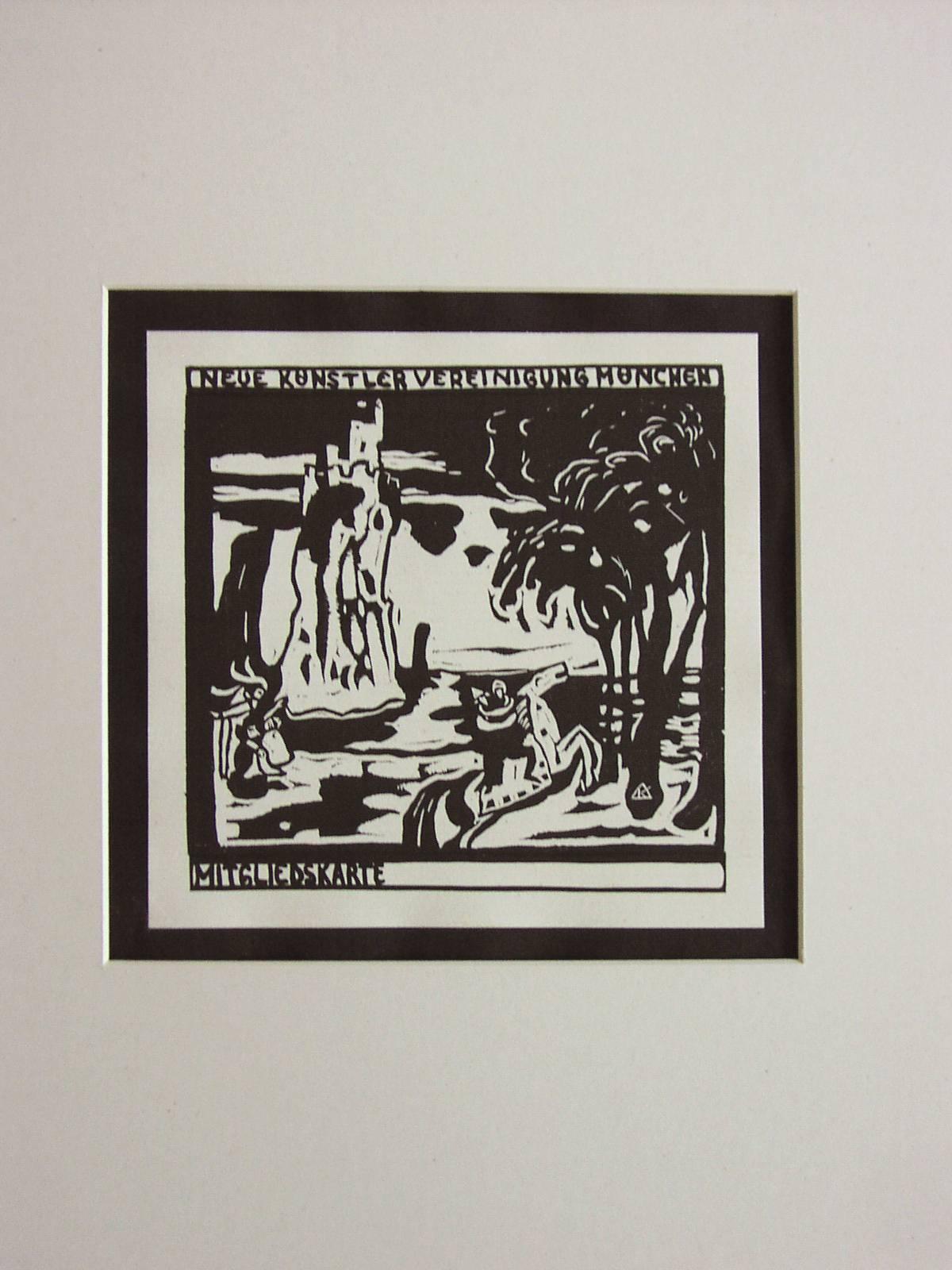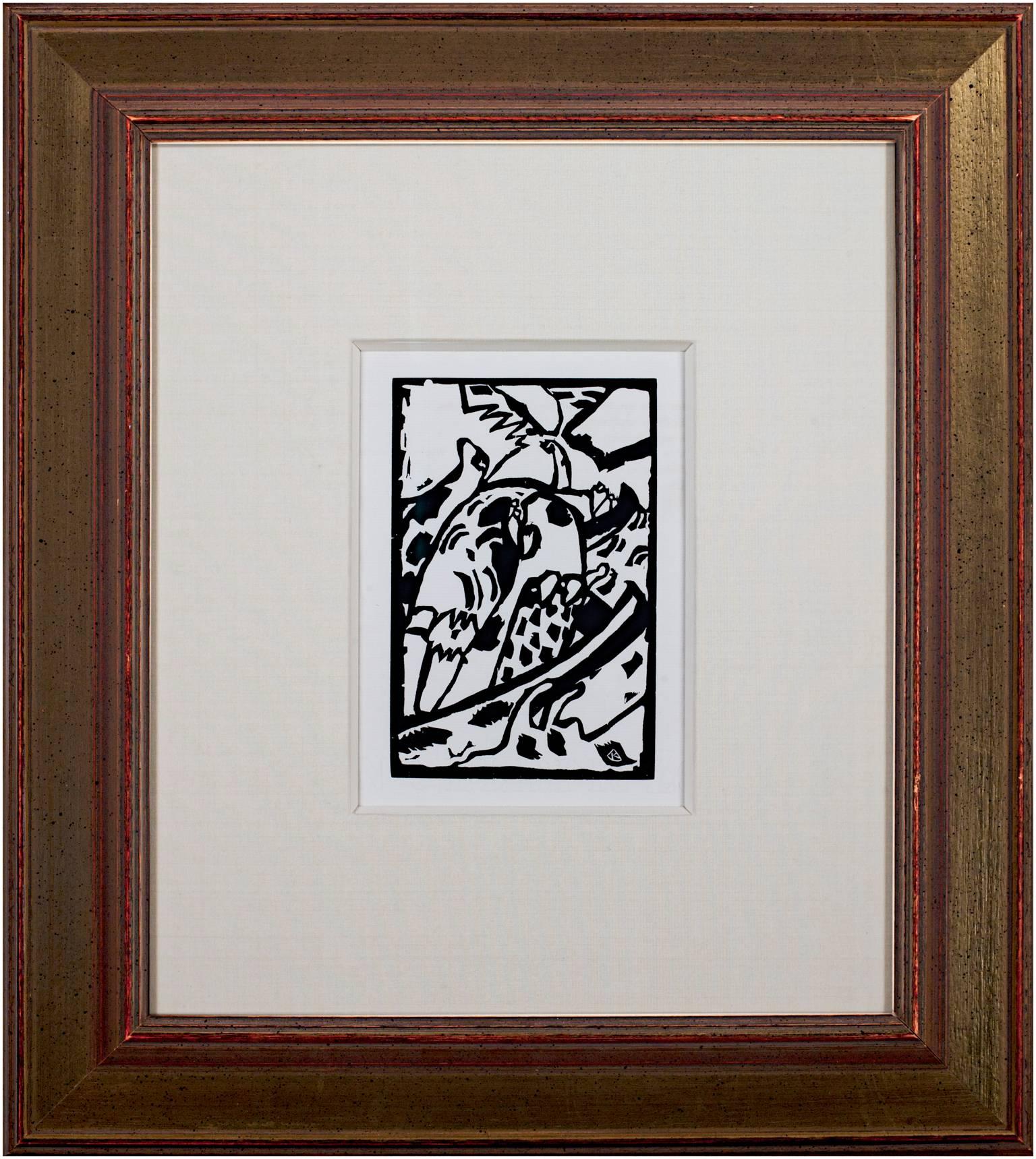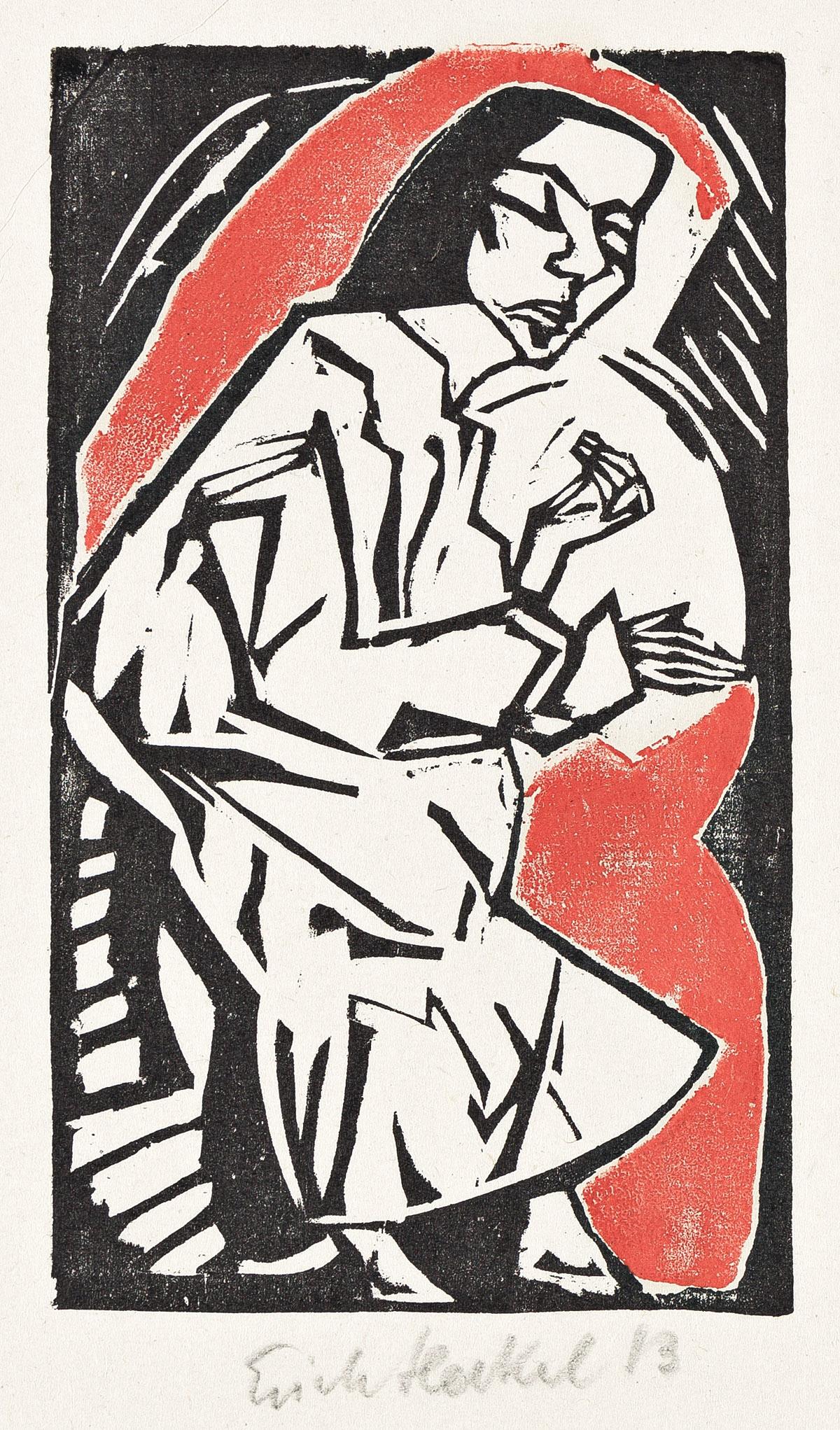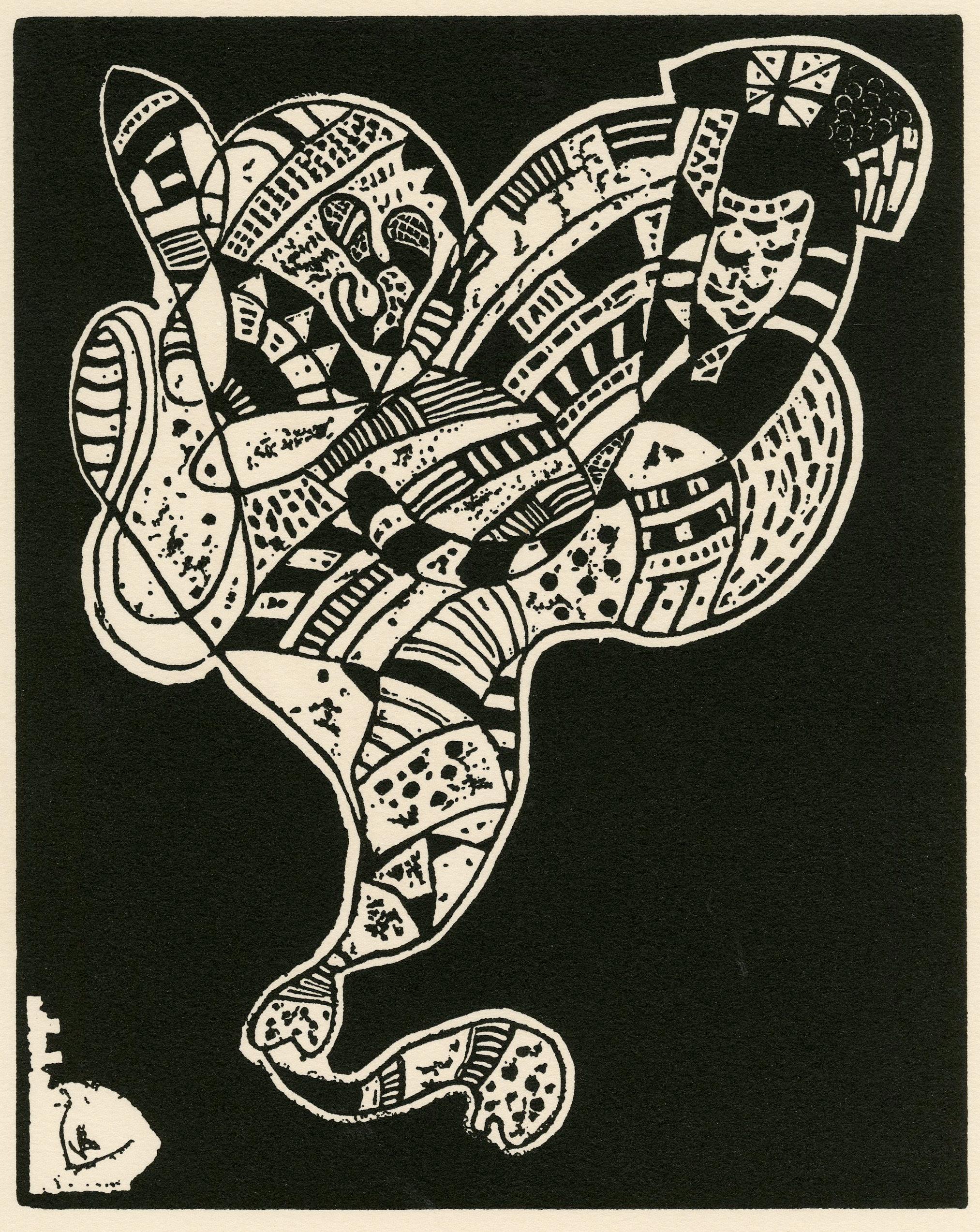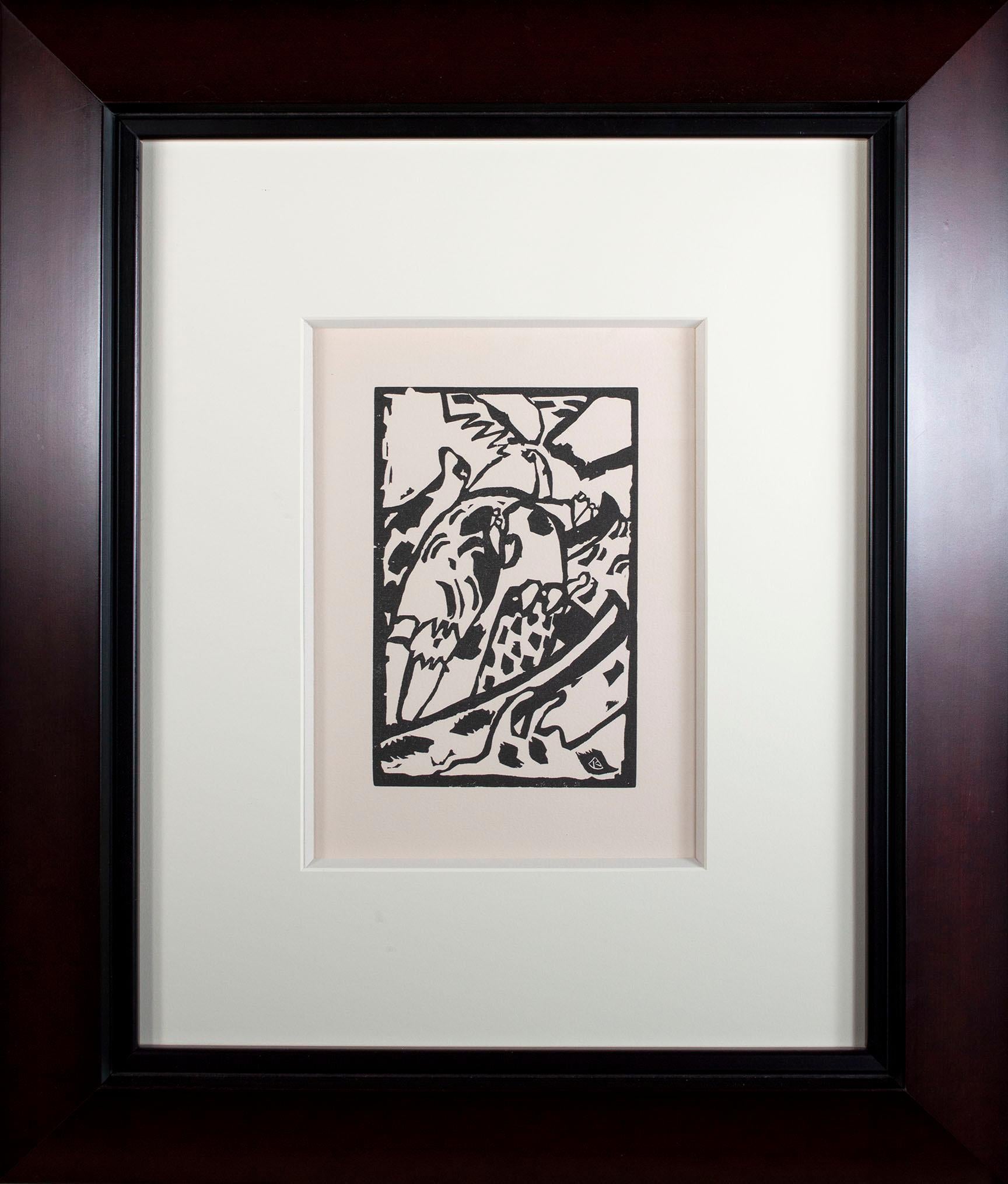Items Similar to Ecce Homo VII
Want more images or videos?
Request additional images or videos from the seller
1 of 7
Werner DrewesEcce Homo VII1921
1921
About the Item
Ecce Homo VII
Woodcut, 1921
Signed, titled, and dated in pencil by the artist
One of only three known impressions
Created while the artist was studying at the Bauhaus in Weimar, Germany.
Extreme rarity-One of three know impressions
Note: In 1921 Drewes went to the Bauhaus in Weimar, where, after completing the compulsory preliminary course with Johannes Itten, he continued to study with Paul Klee, Oskar Schlemmer and Georg Muche and initially went to the wall painting workshop. He then traveled extensively through Europe, North America and Asia. After returning to Germany in 1927, he went back to the Bauhaus, this time to his new location in Dessau, where he studied in the classes of László Moholy-Nagy and Wassily Kandinsky. He was one of the first artists to introduce the groundbreaking concepts of the Bauhaus School in the United States through his painting, printmaking, and teaching.
Condition: Excellent
Missing small voids in the upper margin from removal of the original hinges.
Image size: 9 7/8 x 8 3/16 inches
Reference: Rose 30
Provenance: From the estate of Drewes's teacher at the Bauhaus. During the pasot WW2 the professor lived in East Germany.
WERNER DREWES
1899-1985
Werner Drewes initially studied architecture before enrolling, in 1921-22, at the Bauhaus in Weimar under Klee, Kandinsky, Itten and Feininger. For four years - 1923 to 1927 - he travelled the world with his bride, before completing his Bauhaus training in Dessau in 1929. He immigrated to the United States in 1930, documenting that move to New York through series of woodcuts. In 1936/37 he was an active founder of the American Abstract Artists and participated in the Federal Arts Project in New York before moving on to a teaching career at Washington University in St. Louis.
As an artist for over sixty five years, he employed various media from drawing and watercolor, through woodcut and etching, to painting and collage. Translating an early interest in subjective cubistic forms, his work evolved into nonobjective abstraction. He was creative until the day of his death.
Courtesy: Toby C. Moss
Werner Drewes (1899–1985) was a painter, printmaker, and art teacher. Considered to be one of the founding fathers of American abstraction, he was one of the first artists to introduce concepts of the Bauhaus school within the United States. His mature style encompassed both nonobjective and figurative work and the emotional content of this work was consistently more expressive than formal. Drewes was as highly regarded for his printmaking as for his painting. In his role as teacher as well as artist he was largely responsible for bringing the Bauhaus aesthetic to America.
Early life and education
Drewes was born in 1899 to Georg Drewes, a Lutheran pastor, and Martha Schaefer Drewes. The family lived in the village of Canig within Lower Lusatia, Germany. From age eight to eighteen he attended the Saldria Gymnasium, a boarding school in Brandenburg an der Havel. There, he showed talent both for painting and woodblock printing. Graduating from Saldria in 1917, he was drafted by the German army and served in France from then until the close of the war. About this period of his life he is reported to have said that the horrors of life at the front were only made tolerable by his sketchbook, a copy of Goethe's Faust and a volume of Nietzsche.
For a decade following the close of the war he studied, made paintings and prints, and traveled widely. His friend, Herwarth Walden, helped shape his appreciation for expressionist literature and art. Walden produced the quarterly magazine, Der Sturm and ran a gallery of contemporary art, Galerie Der Sturm, from which, in 1919, Drewes purchased an expressionist painting by William Wauer titled Blutrausch (Bloodlust). In the same year he made the acquaintance of Heinrich Vogeler and participated in Vogeler's socialist utopian artists' commune, Barkenhoff, at Worpswede, Lower Saxony. In 1919 Drewes also enrolled at the Königlich Technischen Hochschule Charlottenburg to study architecture and the following year he studied the same subject at the Technischen Hochschule Stuttgart. Preferring art over architecture, he then enrolled in Stuttgart's school of applied arts (Kunstgewerbeschule) where he studied life drawing and learned to work with colored glass. At this time he joined a group of artists and architects associated with the newly formed Merz Akademie, a college of design, art, and media in Stuttgart.
In 1921 his friendship with a French artist, Sébastien Laurent, led him to begin studies in Weimar at Bauhaus, then a new school which taught an integrated approach to the fine and applied arts. His instructors were Johannes Itten and Lyonel Feininger, whose paintings were expressionist and abstract, and Paul Klee, who taught bookbinding, stained glass, and murals. While at Bauhaus Drewes produced a portfolio of ten woodblock prints entitled "Ecce Homo."
In 1923 and 1924 he studied art during travels throughout Italy, Spain, the United States, and Central America and in 1926 he traveled to San Francisco, Japan, and Korea, thence taking the Trans-Siberian railway to Manchuria, Moscow, and Warsaw. He later said the El Grecos he saw proved to be most influential in his work. While traveling, he exhibited: (1) etchings in Madrid (1923) and Montevideo (1924), oils and etchings in Buenos Aires and St. Louis (1925), and (3) etchings in San Francisco (1926). He paid his way by the sales these exhibits produced and by taking commissions to paint portraits. While in San Francisco he set up a shop from which he sold prints he had made in Spain and South America.
After his return to Germany in 1927 he resumed study at Bauhaus, which had been forced to relocate in Dessau, Saxony-Anhalt. His instructors at that time were László Moholy-Nagy (metal work), Wassily Kandinsky, and (painting), and Lyonel Feininger (prints). At this time he also worked and exhibited in Frankfurt. With the rise of Nazism abstract artists found it increasingly difficult to sell their work and, in 1930, Drewes, finding the political pressure unbearable, emigrated to the United States. There, despite the world economic crisis, Drewes was able to earn a living as a professional artist.
Mature style
After Drewes moved to New York, Kandinsky, who was both friend and mentor, continued to exert a strong influence over his style. Later in life he said he had a hard time getting away from Kandinsky's influence as he developed his own style. In time he was able to bring a more emotional approach to his work and to base it, more than Kandinsky did, on natural forms.
In 1930 Drewes had a solo exhibition at the 135th Street Branch of the New York Public Library and a two-person show at the S.P.R. Penthouse Gallery (with Carl Sprinchorn). Also in that year Kandinsky introduced Drewes to Katherine Dreier, co-founder of the Society of Independent Artists and Société Anonyme. In 1931 Drewes participated in the Société Anonyme's exhibition at the Albright Art Center, Buffalo, New York and the Rand School. That year he showed prints and paintings first in a solo- and then in a two-person exhibition at the Morton Gallery (the latter with Herbert Reynolds Kniffin) and he also exhibited in group shows at the American Institute of Graphic Arts, the Brownell-Lamberton Galleries, and the Pynson Printers Galleries. These exhibitions established pattern, as Drewes's work would be shown multiple times a year throughout the 1930s and 1940s.
From the first, Drewes's work captured the attention of the New York critics. A critic for The New York Times called attention to the subtle treatment in cityscape paintings he exhibited in the dual show with Carl Sprinchorn, noting that they "look fragile, as if they were made from reflections of the city in a soap bubble, rather than from life." In reviewing his solo show at the Morton Gallery, another Times critic praised his work as "solid." She said "though the paint is put on in much the same quick fashion," as the cityscapes at S.P.R. Penthouse, "the composition has something that keeps it from breaking as if touched." Of his solo show at the Morton Gallery Margaret Breuning, the critic for the New York Evening Post praised the "crisp vigor" of his portraits, his skill at handling the form and color of a still life, and the "well developed" and "imaginative" choice of viewpoint in a landscape. "One hopes," she wrote, "and confidently expects to see more work from this young artist." In reviewing the dual exhibition with Herbert Reynolds Kniffin, "T.C.L." of the Times called Drewes "an artist of promise" wrote of his "dynamic quality, an apparent fluency and economy of means," and said "he paints with sureness and vigor, with suggestion rather than in detail." Of this exhibition, the critic for the New York Sun wrote, "Mr. Drewes is an imaginative painter who is worth watching. He has emotions and they take hold of him and lead him at times into paintings that are highly unconventional. As a thousand forces are at work in America today trying to make all the artists conform to set patterns, this ability to withstand influences is a distinct asset."
Howard Devree of The New York Times praised the oils, watercolors, and drawings that Drewes showed in his solo exhibition at the Morton Galleries in 1933. He said the works gave the gallery "a radiantly prismatic aspect." He described some of the landscapes as heavily patterned, others as free and impressionistic and considered his drawings to be vigorous.
In 1934 Drewes began a long career as a teacher when he took a position teaching drawing and printmaking at the Brooklyn Museum Art School funded by the Federal Art Project of the Works Progress Administration. He later said he modeled his teaching method on the one that Kandinsky used. Drewes recalled that Kandinsky was a patient and nonjudgmental teacher who would challenge his students to work out their own solutions to non-objective projects he would set and ask them to discuss the reasons behind their choices.
In 1936, the year he became an American citizen, Drewes became a founding member of both the anti-fascist American Artists' Congress and the avant-garde American Abstract Artists group. That year he also was given a ten-year retrospective exhibition at the Uptown Gallery, and participated in group shows held by Société Anonyme (at Black Mountain College in North Carolina) and the Municipal Art Committee of New York.
In 1937 he participated in the first group exhibitions of the two organizations he had helped to found: a showing of approximately 250 members of the American Artists Congress in the International Building, Rockefeller Center, and another of the 39 members of American Abstract Artists in the Squibb Galleries. Of the former, a critic singled out a painting of his as a "well deliberated" contribution to among those that were non-objective among the polemical and Social-Realist figurative works in the show. In 1937 Drewes also exhibited at the East River Gallery in an innovative program that gave potential buyers the option of renting a work while deciding whether or not to buy it. During the same eventful year a prominent architect, Wallace Harrison, helped Drewes obtain a position at the School of Architecture of Columbia University. He remained there for the next three years teaching painting, drawing, and printmaking while also making prints for the Graphic Arts Division of the WPA Federal Art Project in New York.
Drewes's 1939 exhibition at the Artists' Gallery attracted the notice of New York critics. Jerome Klein in the New York Post said "he handles the vocabulary of 'non-objective' art with the sophistication and assurance of a mature artist who is particularly adept in color relations. In fact there is hardly a spot where his harmony is off the track. And a wide gamut is run from the pale tone of 'Wintry' to the vivid contrasts of 'In the Blue Space.'" Similarly, the reviewer for Art News commented on the "breadth of scope," the "clear eloquent color," and "imaginative designs," of his work and recommended the show to "anyone who searches for meaning in abstractions.
In 1940 Drewes joined with Carl Holty to open an art school called the Department of Abstract Art at the Master Institute of United Arts. Like Drewes, Holty was a founding member of American Abstract Artists and, at the time the school opened, both men were showing works at an exhibition held by that group at the Riverside Museum. The institute and museum were both housed in a 29-story Art-Nouveau apartment building on the upper west side. While teaching at the Institute, Drewes continued as an instructor of drawing and painting at Columbia and held two other positions: director of the WPA/FAP Graphic Arts Project and map maker for the Fairchild Aerial Survey Company.
In the 1930s Fairchild Aerial Survey Company used aerial photography to make tax maps and other political maps for cities and towns. In 1940 U.S. Army Air Corps began testing the airplanes and cameras of the company for aerial reconnaissance and the preparation wide-area survey maps.
In 1941 Howard Devree reviewed a second solo exhibition at Artists Gallery. He wrote that Drewes was a clever artist who could give a human and emotional content to abstract art thus overcoming the sterility that characterized most non-objective art. The gouache, "Grids in Space" shows the emotional content of which Devree wrote. In 1944 and 1945 Drewes worked at Stanley William Hayter's Atelier 17 in New York City. Together, they improved the intaglio technique in color print-making.
Postwar
Drewes's work continued to appear in group exhibitions throughout the years of World War II and in 1945 a solo exhibition at the Kleemann Gallery attracted unusual critical notice. Edward Alden Jewell of The New York Times observed that his work was not exclusively non-objective but included expressionist abstractions that were based on natural objects. The critic for the New York Sun said this tendency to naturalism was handled "lightly and slightly, insisting only on things that seemed essential." Later in the year another Sun critic made the dual aspect of Drewes's work more explicit. Drewes, he said, "seems to differ from most confirmed modernists in that he turns at will from the purely abstract to things that at most are semi-abstract, and in one still life painted in the present year he indulges in a degree of objectivity in the fruit and in the half of a wine bottle that is permitted to show that would shock the believers in non-objective art."
In 1945 Drewes taught design, printmaking, and photography at Brooklyn College and then shifted to Chicago where he joined with Moholy-Nagy to teach at the Institute of Design.
In 1946 he joined the faculty of the St. Louis School of Fine Arts (now the Sam Fox School of Design & Visual Arts) at Washington University in St. Louis. Soon after his arrival he made friends with the German artist, Max Beckmann, who had been hired as an art teacher at the university and who remained there for the next two years. Once settled in St. Louis, Drewes attained a level of financial stability that had until then eluded him. The university promoted him to professor of design and first-year program director and he was thereafter able both to support his family and to devote time to making works of art.
In 1948 Dreves was commissioned by the Edward L. Kramer family to paint a mural on the large front of a new house located at 24 Northcote Drive, Brentwood, MO. He also painted two smaller mural on the wings of the house. A subsequent owner painted over the mural.
While he lived in St. Louis his work frequently appeared in New York galleries. Reviewing a solo exhibition in 1947, Howard Devree praised his turning "from sheer abstraction to well-knit pictures with recognizably representational forms" and noted, "for years I have watched Werner Drewes in his exploration of the field of abstraction. In his current show at Henry Kleemann's Gallery he reveals that he has not abandoned the quest. Rather, he has extended it. In common with many of the best American painters he has submitted himself to a discipline which is definitely paying off." In 1949 another New York Times critic said he "constructs efficient uncompromising designs in aggressive geometrical forms whose separate identity is emphasized by boundaries of harsh, clear color." 1959 Drewes was awarded a purchase prize at the 25th Anniversary National Fine Prints Competition of Associated American Artists.
Later life and work
Drewes retired in 1965 and moved to Reston, Virginia, where he remained active as an artist until his death in 1985. He enjoyed great recognition for his work in these later years. In 1984 a large retrospective at the Smithsonian American Art Museum was devoted entirely to his printmaking. A prolific printmaker, Drewes produced during his lifetime some 732 fine prints, including 269 etchings and drypoints, 30 lithographs, 14 celloprints, a lone silkscreen, and 418 woodcuts, of which 255 were in color. "Autumn Gold" is one of the more colorful of Drewes's non-objective woodblock prints.
Family and personal life
The information in this section expands upon and partly repeats information given above about Drewes's life. He was born on July 27, 1899, in what was then Canig, Lower Lusatia, Brandenburg, Germany, and is now Kaniów, Lubusz Voivodeship, Poland. His name is almost always given as simply Werner Drewes, but his full name was Werner Bernhard Drewes and he is sometimes referred to as Werner B. Drewes. He was the son of Pastor Georg Drewes and his wife Martha Schaefer Drewes. He attended boarding school at the Saldria Gymnasium in Brandenburg an der Havel from 1907 to 1917. At age 18 he was drafted into the German army and served in France, on the Western Front until the end of the war. On returning to civilian life he began to study architecture at the Charlottenburg Technischen Hochschule in Berlin.[2][7] To support himself, he took a job at the Berlin gas and waterworks. He also spent some time at the Barkenhoff artists' commune. His next place of study was the Technischen Hochschule Stuttgart and then, switching from architecture to the visual arts, he enrolled in Stuttgart's Kunstgewerbeschule and joined the Merz Akademie, also in Stuttgart. He completed his education at Bauhaus, where he studied from 1921 to 1923 in Weimar and from 1927 to 1930 in Dessau.
When not attending a school of art, Drewes traveled widely. During 1923 and 1924 he visited places in Italy, Spain, Central America, and the United States and in 1926 he returned to the United States and traveled thence to Japan, Korea, Manchuria, Moscow, and Warsaw. In 1924, while in Madrid, he married Margarete Schrobsdorff, a childhood sweetheart who was also traveling to study art. Margarete had been born on June 16, 1895, in Wust, Saxony-Anhalt, Germany. Her father was Max Schrobsdorff and her mother, Martha Wreger Schrobsdorff. During their marriage she pursued her own art form of weaving and rug making. On November 22, 1927, the couple gave birth to their first child, a son, Harald and two years later, on January 9, 1929, their second son, Wolfram, was born.
In 1930 the family emigrated to the United States and rented an apartment in New York in which to live. At this time Drewes enrolled in the Art Students League. A year later Margarete (now Margaret) gave birth to their third son, Bernard. In 1935 Drewes began his long teaching career with a position at the Brooklyn Museum School and in 1936 he became a citizen of the United States. From the mid-1930s through the 1960s, Drewes flourished both as artist and teacher.
Margaret Drewes died in St. Louis on September 27, 1959. A year later Drewes married Mary Louise Lischer Terhune, who, like him, taught at Washington University in St. Louis. As well as teaching English, she crafted jewelry. In 1965 Drewes retired from Washington University in St. Louis and moved to Point Pleasant, in Bucks County, Pennsylvania. He moved to Reston, Virginia, in 1972 and died there on June 21, 1985.
Courtesy Wikipedia
- Creator:Werner Drewes (1899-1985, American)
- Creation Year:1921
- Dimensions:Height: 9.88 in (25.1 cm)Width: 8.19 in (20.81 cm)
- Medium:
- Movement & Style:
- Period:
- Condition:
- Gallery Location:Fairlawn, OH
- Reference Number:
About the Seller
5.0
Recognized Seller
These prestigious sellers are industry leaders and represent the highest echelon for item quality and design.
Platinum Seller
These expertly vetted sellers are 1stDibs' most experienced sellers and are rated highest by our customers.
Established in 1978
1stDibs seller since 2013
711 sales on 1stDibs
Typical response time: 1 hour
Associations
International Fine Print Dealers Association
- ShippingRetrieving quote...Ships From: Akron, OH
- Return PolicyA return for this item may be initiated within 10 days of delivery.
More From This SellerView All
- Plate 12By Wassily KandinskyLocated in Fairlawn, OHPlate 12 From: 10 Origi, 1942 Signed in the block with the artist's initials lower left (printed) From: 10 Origin Not from the First edition 100, published by Allianz-Verlag, Zurich,...Category
1970s Expressionist Abstract Prints
MaterialsWoodcut
- NightfearBy Karel AppelLocated in Fairlawn, OHNightfear Color lithograph, 1958 From: Rhapsodie de ma nuit, (seven plates) Signed, dated and numbered in pecnil lower left (see photos) Edition: E.A. edition of 25, (there were also 75 impressions numbered) Condition: Excellent, fresh colors and condition Thin spots on reverse from previous hinges Provenance: Martha Jackson Gallery David Anderson Gallery David Anderson granndchildren Trust References And Exhibitions: This portfolio is considered to be one of the greatest-and rarest-illustrated book of the Cobra movement. A copy of this livre d’artiste is in the collection of MOMA. This lithograph is one of four works in color in the portfolio. The book was authored by Emmanuel Looten and published by S.I. (Paris). VERY IMPORTANT EARLY COBRA WORK OF ART Karel Appel B. 1921, AMSTERDAM; D. 2006, ZURICH Karel Appel was born on April 25, 1921, in Amsterdam. From 1940 to 1943 he studied at the Rijksakademie van Beeldende Kunsten, Amsterdam. In 1946 his first solo show was held at Het Beerenhuis, Groningen, Netherlands, and he participated in Jonge Schilders (Young painters) at the Stedelijk Museum, Amsterdam. About this time, Appel was influenced first by Pablo Picasso and Henri Matisse, then by Jean Dubuffet. He was a member of the Nederlandse Experimentele Groep (Dutch Experimental Group, 1948) and established the Cobra group (1948–51) with Constant (Constant Nieuwenhuys), Corneille (Guillaume Cornelis Beverloo), and other painters from Copenhagen, Brussels, and Amsterdam. The style distinguished itself through bold, expressive compositions inspired by folk and children's art, as well as by the work of Paul Klee and Joan Miró. In 1949 Appel completed a fresco for the cafeteria of the city hall in Amsterdam, which created such controversy that it was covered for ten years. In 1950 the artist moved to Paris; there the writer Hugo Claus...Category
1950s Expressionist Abstract Prints
MaterialsLithograph
- AscensionBy Maria DeguchiLocated in Fairlawn, OHEtching and aquatint on Arches France paper Signed, titled, and editioned in pencil by the artist Edition: 60 of which this numbered 23/60 Image: 19 3/4 x 13" Plate: 9 7/...Category
1970s Abstract Prints
MaterialsWoodcut
- Festival No. 6By Katsunori HamanishiLocated in Fairlawn, OHFestival No. 6 Color woodblock, 2002 Signed, titled and numbered in pencil (see photos) Edition: 50 (10/50), see photo Provenance: Ninion and Sheldon Landy Collection, Donors to A...Category
Early 2000s Abstract Abstract Prints
MaterialsWoodcut
- UntitledBy Charles William SmithLocated in Fairlawn, OHUntitled Color woodcut, 1939 Unsigned as issued Signed and dedicated by the artist on the justification page (see photo) From: Abstractions By Charles Smith Forward by Carl O. Schnie...Category
1930s American Modern Abstract Prints
MaterialsWoodcut
- Festival No. 6By Katsunori HamanishiLocated in Fairlawn, OHFestival No. 6 Color woodblock, 2002 Signed, titled and numbered in pencil (see photos) Edition: 50 (10/50), see photo Provenance: Ninion and Sheldon Landy Collection, Donors to A...Category
Early 2000s Abstract Abstract Prints
MaterialsWoodcut
You May Also Like
- Felson,By Wassily KandinskyLocated in New York, NYBlack and White Woodcut. Published in 1909 in an edition of 100 to be used as a card member for the group of artists "Neu Kunstler-Vereingun Munchen". The impression is complete in ...Category
1910s Blue Rider Abstract Prints
MaterialsWoodcut
- Allerheiligen- All Saints Day.By Wassily KandinskyLocated in New York, NYKANDINSKY, Wassily. Allerheiligen- All Saints Day. Original three-color woodcut (red, yellow ochre, blue – with olive green). 1911. Signed with the monogram...Category
1910s Blue Rider Abstract Prints
MaterialsWoodcut
- 'Improvisation 7' original first ed. woodcut from 'Klänge' by Wassily KandinskyBy Wassily KandinskyLocated in Milwaukee, WIThe present woodcut print comes from 'Klänge (Sounds),' a book of original graphics and poetry by Wassily Kandinsky. This first edition was released in an edition of 300, each book signed and numbered by the artist. The title of the album and this particular print, 'Improvisation,' demonstrated Kandinsky's interest in music and how abstract musical forms could be translated into images on a two-dimensional surface. This particular composition is difficult to read, but through the abstraction, one can make out various figures and a landscape beyond. 7.5 x 5 inches, image 22 x 19.5 inches, frame Woodcut in black ink on laid paper (watermark Van Gelder Zonen) Signed with encircled 'K' in the block, lower right Framed to conservation standards using 100 percent acid free archival materials including silk-lined matting with 1/4 inch bevel, museum glass, and a gold-gilded moulding Ref. Roethel 124 The Museum of Modern Art described 'Klänge (Sounds)' as follows: Vasily Kandinsky's self-described "musical album," Klänge (Sounds), consists of thirty-eight prose-poems he wrote between 1909 and 1911 and fifty-six woodcuts he began in 1907. In the woodcuts Kandinsky veiled his subject matter, creating increasingly indecipherable images (though the horse and rider, his symbol for overcoming objective representation, runs through as a leitmotif). This process proved crucial for the development of abstraction in his art. Kandinsky said his choice of media sprang from an "inner necessity" for expression: the woodcuts were not merely illustrative, nor were the poems purely verbal descriptions. Kandinsky sought a synthesis of the arts, in which meaning was created through the interaction of, and space between, text and image, sound and meaning, mark and blank space. The experimental typography shows his interest in the physical aspects of the book. Klänge is one of three major publications by Kandinsky that appeared shortly before World War I, alongside Über die Geistige in der Kunst (Concerning the Spiritual in Art) and the Blaue Reiter almanac...Category
1910s Blue Rider Abstract Prints
MaterialsWoodcut
- LiegendeBy Erich HeckelLocated in New York, NYA very good, richly-inked impression of this color woodcut. Second state (of 2). Signed and dated in pencil. Published by R. Piper & Co., Marées-Gesellschaft, Munich. From "Der Dritt...Category
1910s Expressionist Abstract Prints
MaterialsColor, Woodcut
- 'Improvisation 7' second ed. woodcut from 'Klänge' by Wassily KandinskyBy Wassily KandinskyLocated in Milwaukee, WI'Improvisation 7' second ed. woodcut from 'Klänge' is a woodcut print created by Wassily Kandinsky. The present woodcut print comes from the second edition of 'Klänge (Sounds),' a book of original graphics and poetry by Wassily Kandinsky. The title of the album and of this print, 'Improvisation,' demonstrated Kandinsky's interest in music and how abstract musical forms could be translated into images on a two-dimensional surface. This particular composition is difficult to read, but through the abstraction, one can make out various figures and a landscape beyond. Originally carved and printed in 1911, this second edition print was done ca. 1938. It is a woodcut in black ink on woven paper. Signed with encircled 'K' in the block, lower right (from the book, signed in ink, ed. 117/300) Image Size: 7 1/2" x 5 inches Frame Size: 22 1/4" x 18 3/4" Ref. Roethel 124 Artist Bio: The Museum of Modern Art described 'Klänge (Sounds)' as follows: Vasily Kandinsky's self-described "musical album," Klänge (Sounds), consists of thirty-eight prose-poems he wrote between 1909 and 1911 and fifty-six woodcuts he began in 1907. In the woodcuts Kandinsky veiled his subject matter, creating increasingly indecipherable images (though the horse and rider, his symbol for overcoming objective representation, runs through as a leitmotif). This process proved crucial for the development of abstraction in his art. Kandinsky said his choice of media sprang from an "inner necessity" for expression: the woodcuts were not merely illustrative, nor were the poems purely verbal descriptions. Kandinsky sought a synthesis of the arts, in which meaning was created through the interaction of, and space between, text and image, sound and meaning, mark and blank space. The experimental typography shows his interest in the physical aspects of the book. Klänge is one of three major publications by Kandinsky that appeared shortly before World War I, alongside Über die Geistige in der Kunst (Concerning the Spiritual in Art) and the Blaue Reiter almanac...Category
1910s Blue Rider Abstract Prints
MaterialsWoodcut, Laid Paper
- GelsominaLocated in London, GBSigned and numbered 20/20 Silkscreen print on Somerset enhanced velvet fine art paper 330 gsm 29.7 x 42 cm Framed (matte black wooden frame, black mount, UV anti-reflective museum ...Category
2010s Expressionist Abstract Prints
MaterialsScreen
Recently Viewed
View AllMore Ways To Browse
Ww2 Style Watch
Ww2 Style Watches
Ww2 Mens Watch
Italian Village 1920
Ww2 Field Watch
Ww2 Airplane
Saxony Art Nouveau
World War 2 Airplane Models
Citizens Gold Watch
Ten Thousand Things Jewelry
Shop Crafter Oskar
Mr Clever
West Virginia Map
St Sebastien
Mens Watch 1959
French Art Paintings Formal Louis
Estate Of Rockefeller
Bucks County Estate
